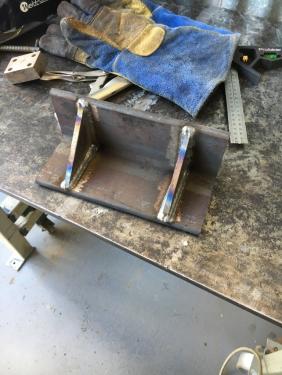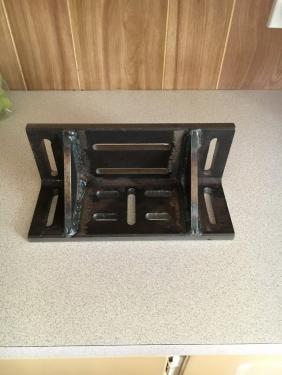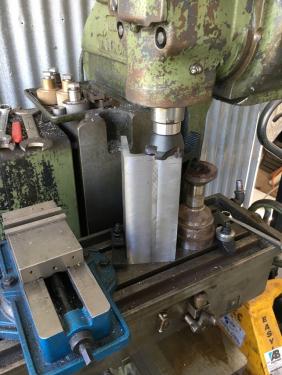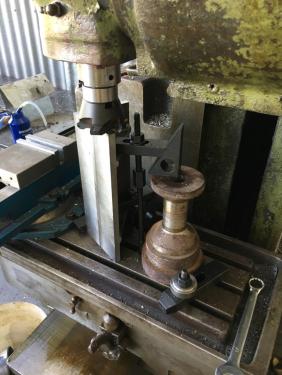Posts: 130
Threads: 17
Joined: Dec 2016
Location: Melbourne, Australia
Inside has 2 welded in webs if that makes any difference to where the holes/slots should go.

Steve
Posts: 3,003
Threads: 51
Joined: Apr 2012
Location: Ontario
I made two like yours a while back, still haven't drilled or slotted them. I have one about 6 x 6 x 8 long, one face has slots vertical and the other horizontal. That actually works quite well giving options.
Have read they are to be considered as consumables, drill and tap as needed, kind of makes sense.
Free advice is worth exactly what you payed for it.
Greg
Posts: 4,683
Threads: 93
Joined: Feb 2012
Location: Perth, Australia
I'd probably slot horizontal on one face and vertical on the other between the webs. I'd put a vertical slot between the web and the edges if there is sufficient room.
Hunting American dentists since 2015.
Posts: 432
Threads: 27
Joined: Feb 2016
Location: Woodstock:GA
Steve,
Enjoyed seeing the build progress......
Nice\Greg
Magazines have issues, everything else has problems
Posts: 130
Threads: 17
Joined: Dec 2016
Location: Melbourne, Australia
The following 4 users Like SteveG's post:
Mayhem (01-15-2018), f350ca (01-15-2018), EdK (01-15-2018), Pete O (01-15-2018)
Well its now got slots. Not what I'd call good slots, but slots nonetheless.
Some vertical, some horizontal. I managed to take a photo that doesn't show how rough they really are


First time I've plunged with a slot drill, and it didn't go all that well. I had one flange clamped vertically in the vice, cutting the slots on the horizontal flange with a 10mm 2-flute HSS slot drill.
Locked the X and Y axis but still had the whole lot wriggling around on me and the plunge holes were quite oversize. I know you should't use a 10mm slot drill if you want a 10mm slot, but my max RPM on the mill is 1465 RPM so really only just fast enough to spin the 10mm. Also the slot size wasn't critical as long as it could take the 3/8" clamping studs that I've got for the mill so I decided just to go with the 10mm cutter.
Hindsight has me thinking that it would have been better to clamp it directly to the table (flange down) using some spacer blocks or machinist jacks underneath. Flange up wouldn't give enough clearance on the ER32 collet holder I'm using. Probably using an 8mm slot drill would have been better than the 10mm too.
As a milling newbie its been a really good learning project and will hopefully be a useful tool.
Steve
Posts: 3,003
Threads: 51
Joined: Apr 2012
Location: Ontario
Looks great !
Free advice is worth exactly what you payed for it.
Greg
Posts: 2,328
Threads: 271
Joined: Jun 2014
Location: La Libertad, Philippines
01-15-2018, 01:00 PM
(This post was last modified: 01-15-2018, 01:03 PM by Dr Stan.)
When ever you cut a slot it needs to be cut with an undersized end mill as they will pull off to one side and cut oversized. A keyway cutter performs better, but will still pull & cut oversized. This is especially important when cutting key seats in shafts.
BTW, the angle plate looks good.

Posts: 130
Threads: 17
Joined: Dec 2016
Location: Melbourne, Australia
(01-15-2018, 01:00 PM)Dr Stan Wrote: When ever you cut a slot it needs to be cut with an undersized end mill as they will pull off to one side and cut oversized. A keyway cutter performs better, but will still pull & cut oversized. This is especially important when cutting key seats in shafts.
BTW, the angle plate looks good. 
Thanks. I need to have a play around on some scrap stock and just cut a few more slots for practice.
Not 100% sure what you mean by a keyway cutter. You mean like a woodruff key cutter or is there a special endmill/slot-drill style just specially for keyways?
Steve
Posts: 2,328
Threads: 271
Joined: Jun 2014
Location: La Libertad, Philippines
(01-15-2018, 04:59 PM)SteveG Wrote: is there a special endmill/slot-drill style just specially for keyways?
Steve
There is a special cutter for key seats. It is effectively an end mill with straight rather than helical cutting edges. Does a better job of holding size and does not pull off to the side as much. Typically used after the key seat or slot has been roughed out with an end mill.








